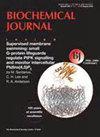The C-terminal structure of the N6-methyladenosine deaminase YerA and its role in deamination.
IF 4.3
3区 生物学
Q2 BIOCHEMISTRY & MOLECULAR BIOLOGY
引用次数: 0
Abstract
The N6-methyladenine (6mA) modification is an essential epigenetic marker and plays a crucial role in processes, such as DNA repair, replication, gene expression regulation, etc. YerA from Bacillus subtilis is considered a novel class of enzymes capable of catalyzing the deamination of 6mA to produce hypoxanthine. Despite the significance of this type of enzymes in bacterial self-defense systems and potential applications as a gene-editing tool, the substrate specificity, the catalytic mechanism and the physiological function of YerA are currently unclear due to the lack of structural information. In this study, we expressed the recombinant enzyme and conducted its reconstitution to yield the active form. Our deamination assays showed that N6-methyladenosine (N6-mAdo) served as a more favorable substrate than its base derivative 6mA. Here we report the high-resolution structure of the C-terminal region of YerA, which exhibited a compact architecture composed of two antiparallel b-sheets with no obvious close structural homologs in PDB. We also created docking models to investigate the ligand-binding pattern, and found that more favorable contacts of N6-mAdo with the enzyme binding pocket lead to its preference for 6mA. Lastly, structural comparison to the deaminase MAPDA allowed us to propose a plausible role for this C-terminal region: shielding the active site from solvent and protecting the intermediate during catalysis. Taken together, this study sheds light on the catalytic mechanism and evolutionary pathways of the promiscuous enzyme YerA, thereby contributing to our molecular understanding of epigenetic nucleoside metabolism.n6 -甲基腺苷脱氨酶YerA的c端结构及其在脱氨中的作用。
n6 -甲基腺嘌呤(6mA)修饰是一种重要的表观遗传标记,在DNA修复、复制、基因表达调控等过程中起着至关重要的作用。枯草芽孢杆菌中的YerA被认为是一类能够催化6mA脱氨生成次黄嘌呤的新型酶。尽管这类酶在细菌自我防御系统中的重要性以及作为基因编辑工具的潜在应用,但由于缺乏结构信息,YerA的底物特异性、催化机制和生理功能目前尚不清楚。在本研究中,我们表达了重组酶,并对其进行了重组,得到了活性形式。我们的脱胺实验表明,n6 -甲基腺苷(N6-mAdo)是比其碱衍生物6mA更有利的底物。本文报道了YerA的c端区域的高分辨率结构,其结构紧凑,由两个反平行的b片组成,在PDB中没有明显的紧密同源物。我们还建立了对接模型来研究配体结合模式,发现N6-mAdo与酶结合口袋更有利的接触导致其对6mA的偏好。最后,通过与脱氨酶MAPDA的结构比较,我们提出了该c端区域的合理作用:在催化过程中屏蔽活性位点和保护中间体。综上所述,本研究揭示了混杂酶YerA的催化机制和进化途径,从而有助于我们对表观遗传核苷代谢的分子理解。
本文章由计算机程序翻译,如有差异,请以英文原文为准。
求助全文
约1分钟内获得全文
求助全文
来源期刊

Biochemical Journal
生物-生化与分子生物学
CiteScore
8.00
自引率
0.00%
发文量
255
审稿时长
1 months
期刊介绍:
Exploring the molecular mechanisms that underpin key biological processes, the Biochemical Journal is a leading bioscience journal publishing high-impact scientific research papers and reviews on the latest advances and new mechanistic concepts in the fields of biochemistry, cellular biosciences and molecular biology.
The Journal and its Editorial Board are committed to publishing work that provides a significant advance to current understanding or mechanistic insights; studies that go beyond observational work using in vitro and/or in vivo approaches are welcomed.
Painless publishing:
All papers undergo a rigorous peer review process; however, the Editorial Board is committed to ensuring that, if revisions are recommended, extra experiments not necessary to the paper will not be asked for.
Areas covered in the journal include:
Cell biology
Chemical biology
Energy processes
Gene expression and regulation
Mechanisms of disease
Metabolism
Molecular structure and function
Plant biology
Signalling
 求助内容:
求助内容: 应助结果提醒方式:
应助结果提醒方式:


